
Mixing minerals for the garden
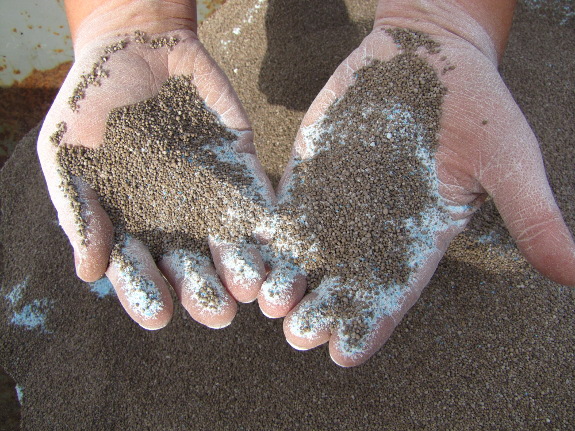
I did the first round of
remineralization of our garden soil this week. If you haven't
been reading along, you can learn how I
figured out how much of each mineral I needed here and here, and I also recommend
checking out the book The
Intelligent Gardener
for more information on why we want to remineralize our soil.
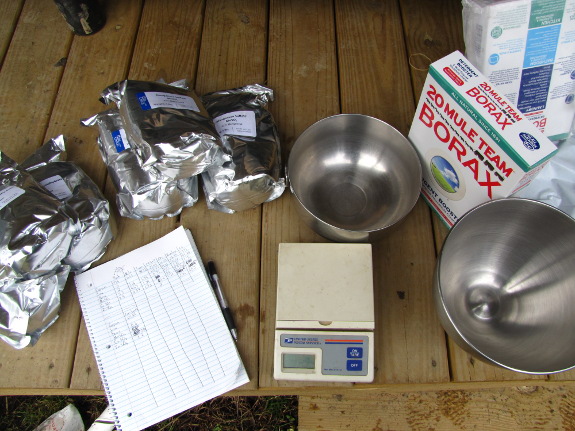
After doing the math to
calculate amounts, the next step was to come up with the
minerals. I could have asked our feed store to order 50 pound
bags of each, saving about 50% per pound. But we only needed 10
or 15 pounds of several different minerals, and you have to keep
moisture out of some of the compounds during storage. In our wet
climate, I figured it made more sense to order smaller quantities
online, and Alpha
Chemicals seemed to
be the cheapest choice for most.
As a side note, I'm 95%
sure that even though 20 Mule Team Borax is marketed as a laundry
additive, the box contains pure borax. If my garden
starts sudsing up, I'll let you know....
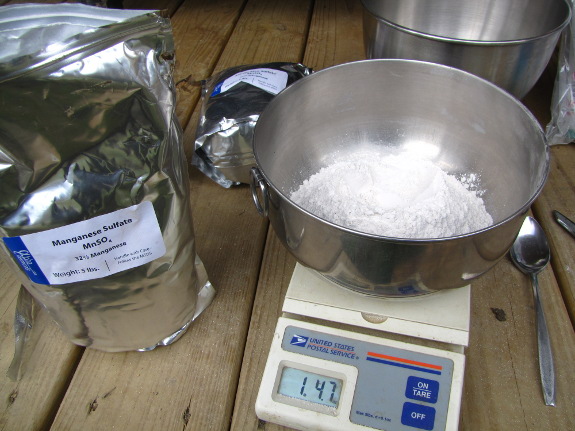
I used a scale and some
mixing bowls to weigh out the quantities of the minerals I'm adding in
small amounts --- manganse sulfate, copper sulfate, zinc sulfate, and
borax. Even though my soil analysis called for salt, my
understanding of soil cations talked me into leaving the
salt out this year. Every part of our garden is getting gypsum to
flush out excess cations, and sodium is the cation that clings least
tenaciously to the soil particles. My understanding of the
chemistry says that if I add salt and gypsum at the same time, I'd be
flushing my salt right out of the dirt.
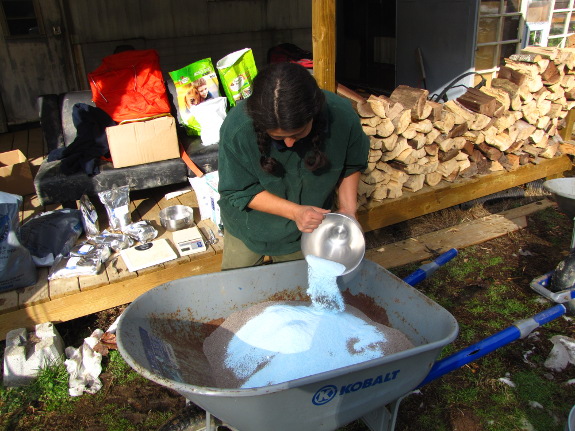
Solomon recommends
mixing all of the trace minerals together, then adding them to the
items you use in bulk (like gypsum and lime). I followed his lead
on my first garden area, but I won't in the future. Our gypsum
came from the feed store pelletized, and the other minerals are
powders, so the latter tend to sink to the bottom of the wheelbarrow no
matter how carefully you mix them together. Luckily, I spread
sparingly, making three passes over the garden, so each garden spot
probably got a relatively even helping of the trace minerals as well as
the gypsum. (There's no lime in this garden area, but I plan to
mix the lime and gypsum together for areas that use both.)
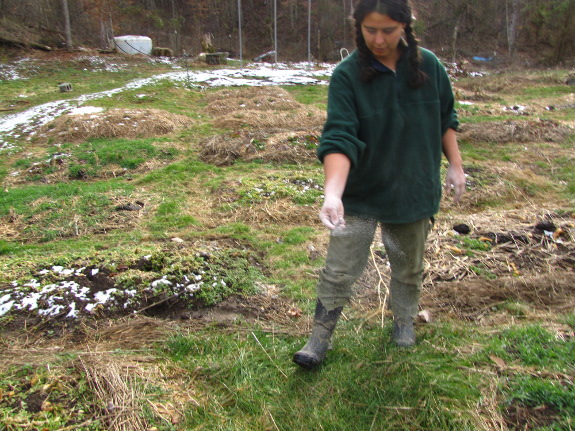
I crunched the numbers
to include spreading amendments on the aisles as well as on the
beds. I could have saved cash by only treating the latter, but I
figure some vegetables probably spread their roots out beyond the bed
boundaries, and we sometimes use grass clippings as mulch, so it's best
to remineralize everything.
Each garden zone gets
its individual prescription, and I've only treated the front garden so
far. I'll let you know how I change my technique as I hit the
other areas in turn. Meanwhile, I should tell you that we've
already spent $169 on the trace minerals, and we'll be spending at
least that much again on the gypsum and lime, so this isn't a cheap
proposition. If we can taste the results in the first year,
though, it'll be worth it.
Want more in-depth information? Browse through our books.
Or explore more posts by date or by subject.
About us: Anna Hess and Mark Hamilton spent over a decade living self-sufficiently in the mountains of Virginia before moving north to start over from scratch in the foothills of Ohio. They've experimented with permaculture, no-till gardening, trailersteading, home-based microbusinesses and much more, writing about their adventures in both blogs and books.
Want to be notified when new comments are posted on this page? Click on the RSS button after you add a comment to subscribe to the comment feed, or simply check the box beside "email replies to me" while writing your comment.

Charity --- I generally figure if I can do something by hand nearly as well, I'll do without equipment, but I'm sure we could have bought some kind of broadcaster at the local feed store. Some people recommend dissolving minerals used in very small amounts in water and spraying them on for even dispersal, which I was simply too lazy to do.
I haven't gotten to the mule garden, which is where most things are growing right now, but I'll probably just spread minerals like I did on the sleeping garden. We get a lot of rain, so I suspect anything that sticks to leaves will soon end up in the soil, and I hope that any clumps that come about from my less-than-scientific broadcasting method will also wash through the soil in our frequent rains.
Anna, most of your trace minerals (sulfates) are labeled as either harmful or irritating to the eyes and/or skin and dangerous to then aquatic environment. You shouldn't breathe the dust. Consider wearing gloves and safety glasses when mixing and spreading them.
Remember that the dose makes the poison, and you are handling these materials in their pure form instead of severely diluted.
I would agree that copper(II)sulfate is probably the most dangerous of the bunch. Read the "Toxicological effects" section, and the linked MSDS. Don't swallow it, and wash your hands with water and soap after skin contact.
Since it irritates the gastro-intestinal tract, you'll probably vomit it up if you swallow enough of it. But if that doesn't happen soon enough it can damage the liver or kidneys. Quantities in the order or grams can be fatal if swallowed.
Anna,
What take away do you think I should get from all this soil information?
My "farm" consists of containers, and I have saved the soil from last year in large barrels. I am adding 15+ 18 Gallon earth boxes. I will need at least 50% more soil for the containers than I have on hand. Much of that volume will be added too with Coco coir and composted manure.
Before the freeze set in I added bokashi, brown compostables and nitrogen heavy ingredients the stored soil with the hope of improving the "used" soil. I should be able to continue that in a few weeks as the thawing starts. I also plan to mix these with good amounts of coco coir, composted manure, Azomite, glacial rock dust, bone meal, and potassium rich fertilizers, and more perlite. I will check the PH levels after that, and make adjustments as needed. Once the transplants take root, compost teas with EM-1 and water soluble foods will be my plan. [Oh, I have several comfrey plants and I will be doubling down on them this summer.]
Any thoughts or ideas on what I might want to review to be comfortable that I have a good plan?